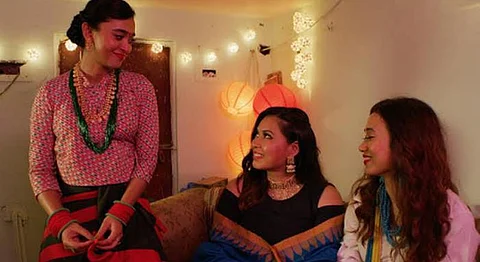
- #HGWORLD
- #HGCREATORS
- #HGEXPLORE
- #HGVOICES
- #HGSHOP
- CAREERS
- ABOUT US
- CONTACT US

Netflix’s recent release ‘Axone’ directed by Nicholas Kharkongor has stirred a fair degree of conversation, as it presents a rarely-discussed and massively-overlooked theme—otherism against people from the North East in northern India. Named after a Naga condiment, the film follows the story of a group of friends from the different states of North East India who go through various trials and tribulations in their attempts to organise a wedding party for one of their friends. The film premiered at the London Film Festival on 02 October 2019, and was released by Netflix India on 12 June 2020.
About axone itself, The Hindu informs, “Named after a Naga condiment made from fermented soya beans, the word [axone] comes from ‘axo’ meaning smell and ‘ne’ meaning strong in the Sumi Naga dialect.“A rough paste stored in banana leaf packets, axone is added to smoked pork or beef, snails or vegetable stew for that extra kick. But like durian, axone has a strong, pungent smell that takes a lot of getting used to, a smell beloved in the Northeast but unknown elsewhere.”
To the Shillong-born director, axone assumes the character of a metaphor for people from the North-east in Delhi.
Author Janice Pariat, who also hails from Shillong, unpacks the various nuances the film tries to capture and comments on the wins and failings of the film in a striking note here.
Read on.
“So many messages asking for thoughts on Axone — which I just recently watched. To begin with, a film about a group of “Northeasterners”, written and directed by a filmmaker from the region (Shillong, to be precise), showing on Netflix. That’s a huge win. And something to be applauded. Because, let’s face it, it’s the rarest of rare occurrences. Also, it doesn’t star Priyanka Chopra as a Manipuri character. Hugest relief.
The film is honest about many things – the sexual harassment, violence, abuse, and discrimination, that people from India’s North East face in the capital city – sadly, so much of it, rings familiar.
I liked that it centres around the politics of food – what we can cook and eat, and nourish ourselves with is so indicative of being “at home” (or not). Food as a symbol of community, memory, homesickness, celebration, love, where the simple act of cooking one’s own food allows entry into a space of conflicting cultures.
I was less comfortable with the clubbing together of all the “northeasterners”– like a Northeast United team, a Seven Sisters club. In this instance, this clubbing together erases class, as though all migration from the North East to the capital takes place under one common banner, which it doesn’t. It also serves to erase any sense of individuality, as though one northeasterner is happily interchangeable with another. This banding together also erases opportunity for backstory–an essential element in understanding why this migration largely takes place, to begin with. Often people from the North East are fleeing political and social instability, resource extraction, lack of infrastructure and employment opportunities, environmental degradation, all stemming largely from the North East being exploited as a resource-rich frontier by the State. When Bendang shouts “You fucking Indian” at Shiv (the landlord’s son), and Zorem remains guiltily silent when Shiv asks him “Don’t you people consider yourselves Indian?” – that, sadly, was a tremendous opportunity wasted to at least hint at the weight of history some of the characters were carrying.
The inclusion of a Nepali character, I thought, was a thoughtful, nuanced touch (throwing up questions: what is the “northeast?” where do its borders lie? who has rights over claiming to be northeastern? who is more “northeast” than whom?), though as friends from Assam asked, “Where’s the Assamese?” And someone sorrowfully wrote to me saying no one even noticed there wasn’t a character from Tripura.
The end was much too happy-clappy, I thought. Bendang, still visibly suffering from PTSD (after almost being beaten to death in a racist attack a few years ago), playing the guitar, singing ‘Uthe sab ke kadam … kabhi khushi kabhi gham’, seemed mere wish fulfilment on the director’s part which wouldn’t be as problematic if it wasn’t coupled with victim-blaming. Bendang’s girlfriend Chanbi chides him for “not making an effort to mingle with anyone outside the region”, and throws out some cringe-worthy platitude like “they’re nice to us and that’s why we live here.” This is terrifying – to place the blame on the victim, and make him feel guilty, and it’s especially more insidious because it’s perpetuated from within.
What’s been interesting is people’s reactions to the movie, the one common complaint being “it could’ve done so much more”. This is true, but I think it did what it tried to do – tell a story in very broad strokes highlighting the discrimination that a certain community faces. In this ‘broadness’, sadly, much is definitely lost.
One movie, however, cannot possibly rectify the abysmal lack of representation the North-East suffers in mainstream Indian culture. We can see it as a catalytic offering, a start of conversations, the beginning of hopefully many more movies that are widely accessible/screened from the region and offer a far more nuanced representation of people from the region. For this much, we can be grateful.
If you enjoyed reading this article, we suggest you also read:
